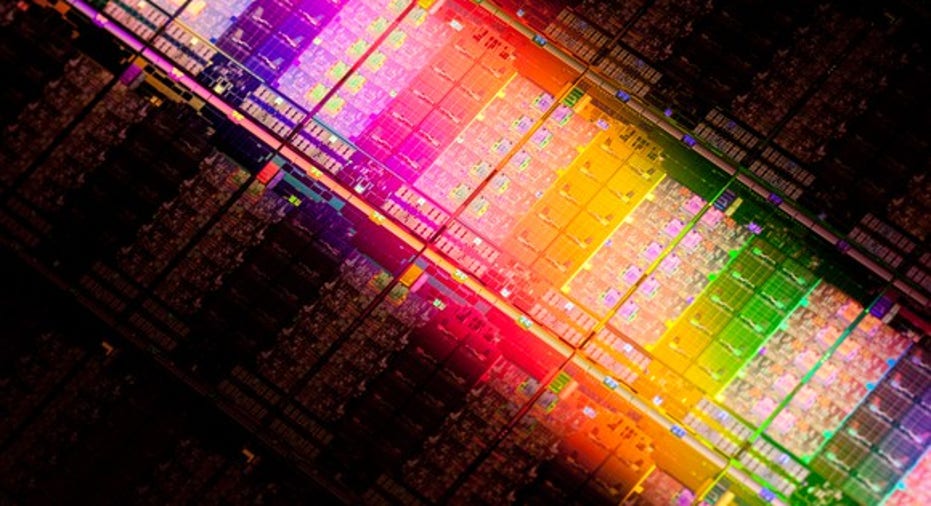Inside Intel Corporation's Foundry Ambitions

At Intel's (NASDAQ: INTC) Technology and Manufacturing (TMG) Day event, the company spent a good deal of time talking about how it's aiming to build a "foundry franchise."
That is, Intel -- a company that has traditionally designed and built its own chips -- wants to leverage its chip manufacturing expertise and its expensive chip manufacturing plants to generate additional revenue by building chips for third-party chip manufacturers.
Image source: Intel.
Intel pegs the total addressable market for what it calls "leading edge" chip technology (28-nanometer technology and below) at about $23 billion.
That said, just because a market is large and a company has ambitions to play in it doesn't mean much if a company can't capture a significant portion of said market.
During a question-and-answer session at Intel's TMG day, one analyst asked Intel executives about its long-term ambitions in this market and whether it would build chips for competitors (as some of the foundry total addressable market overlaps with Intel's own product lines).
Let's look at what Intel executive Murthy Renduchintala had to say.
No publicly stated ambitions
Unfortunately, Renduchintala declined to provide long-term market share goals/ambitions for Intel's foundry business. He did say the following, though: "I think specific ambitions, we haven't declared any beyond the fact that I think that there are strategic partnerships and co-learning that could be available to [Intel] that could be mutually beneficial both to the internal product businesses of Intel and to, as well as, essentially providing a degree of extension of our foundry capability for other relationships."
Considering that Intel isn't generating any meaningful revenue from its contract chip business today, any targets that Intel puts out today probably wouldn't be all that credible, anyway.
Will Intel build chips for competitors?
Renduchintala didn't directly answer the question about potentially building chips for competing chipmakers. However, he did provide something of an indirect answer.
"I don't think we're setting ourselves up to be a general-purpose foundry," Renduchintala said. "We're really looking at strategic partnerships that essentially deliver win-win arrangements both for Intel and their customers and a degree of technical cooperation that's part of that win-win story."
Image source: Intel.
It's not hard to read this as a "no." After all, if Intel really has technology that could fundamentally improve the competitiveness of a product that directly competes with significant Intel-designed products, then would it really be a "win-win" to enable that competitor?
Of course not! It would be much smarter for Intel to leverage whatever manufacturing technology advantage that it must make its own products better to defend market-share against challengers to its leadership position while at the same time trying to grow its market share in areas where it's a relatively small player today.
An example of a "win-win" would be if Intel worked with a third-party chipmaker that builds chips for a market that Intel doesn't serve today.
For example, Intel doesn't really participate in the tablet/smartphone applications processor market today. So, a "win-win" for Intel would be to collaborate up with a company that builds smartphone chips and build a large portion of that company's chips.
That's what the company is doing with mobile chip vendor Spreadtrum today.
If Intel's technology really provides a performance and/or cost benefit compared to other technologies, then the potential customer wins and, of course, Intel would win (since it wouldn't otherwise derive any revenue from those smartphone chip sales).
The challenge that Intel faces is that the competition in this market is quite strong and Intel's chip manufacturing competitors in this market have spent years building tight relationships with the major mobile chipmakers. Breaking those bonds won't be easy.
Foolish takeaway
At the end of the day, investors shouldn't bet on any serious near-to-medium term revenue from Intel's contract chip division -- it'll be a while before the money starts flowing, if it ever does.
Keep an eye on the progress that Intel makes here, though. If the public starts to get clear signs that Intel is gaining traction with major mobile chipmakers, then that'll be the time to start thinking about the potential revenue and profit contributions to Intel from such business.
Until then, though, I wouldn't factor in any meaningful upside from these efforts into any potential financial models.
10 stocks we like better than IntelWhen investing geniuses David and Tom Gardner have a stock tip, it can pay to listen. After all, the newsletter they have run for over a decade, Motley Fool Stock Advisor, has tripled the market.*
David and Tom just revealed what they believe are the 10 best stocks for investors to buy right now... and Intel wasn't one of them! That's right -- they think these 10 stocks are even better buys.
Click here to learn about these picks!
*Stock Advisor returns as of February 6, 2017
Ashraf Eassa owns shares of Intel. The Motley Fool recommends Intel. The Motley Fool has a disclosure policy.